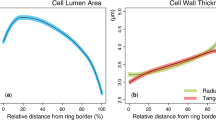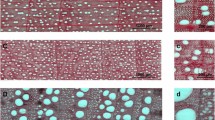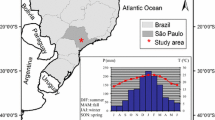Abstract
Developing long-term chronologies of tree-ring anatomical features to evaluate climatic relationships within species might serve as an annual proxy to explore and elucidate the climatic drivers affecting xylem differentiation. Pinus leucodermis response to climate was examined by analyzing vertical xylem resin ducts in wood growing at high elevation in the Apennines of peninsular Southern Italy. Early- and latewood tree-ring resin duct chronologies, spanning the 1804–2010 time period, were constructed. We analyzed the relationships between resin duct chronologies and climate over the last century using correlation and response function analyses. Overall, results showed that ring width and resin duct relationships differed between early- and latewood, which indicated conditions affecting growth were not associated with resin duct production. Results also revealed differential responses to climate between early- and latewood resin duct chronologies. A notable observation was a positive and stable relationship between latewood resin duct number chronology and July maximum temperature throughout the twentieth century. This result suggested resin ducts might be a suitable proxy to evaluate P. leucodermis response to climate in the study area.





Similar content being viewed by others
References
Abeles FB, Morgan PW, Saltveit ME Jr (1992) Ethylene in plant biology, 2nd edn. Academic, San Diego
Akaike H (1992) Information theory and an extension of the maximum likelihood principle. In: Kotz S, Johnson NL (eds) Breakthroughs in statistics. Foundations and basic theory. Springer Science + Business Media, New York, pp 610–624
Bates D, Maechler M, Bolker B, Walker S (2015) Fitting linear mixed-effects models using lme4. J Stat Softw 67:1–48
Blanche C, Lorio P, Sommers R, Hodges J, Nebeker T (1992) Seasonal cambial growth and development of loblolly pine: xylem formation, inner bark chemistry, resin ducts, and resin flow. For Ecol Manag 49:151–165
Bunn A, Korpela M, Biondi F, Campelo F, Mérian P, Qeadan F, Zang C (2016) dplR: dendrochronology program library in R. R package version 1.6.4. https://CRAN.R-project.org/package=dplR
Cook ER, Krusic PJ (2005) Program ARSTAN: a tree-ring standardization program based on detrending and autoregressive time series modeling, with interactive graphics. Lamont-Doherty Earth Observatory, Columbia University, Palisades
Deslauriers A, Rossi S, Anfodillo T, Saracino A (2008) Cambial phenology, wood formation and temperature thresholds in two contrasting years at high altitude in southern Italy. Tree Physiol 28:863–871
Ferrenberg S, Kane JM, Mitton JB (2014) Resin duct characteristics associated with tree resistance to bark beetles across lodgepole and limber pines. Oecologia 174:1283–1292
Franceschi VR, Krekling T, Christiansen E (2002) Application of methyl jasmonate on Picea abies (Pinaceae) stems induces defense-related responses in phloem and xylem. Am J Bot 89:578–586
Friedman JH (1984) A variable span smoother. Laboratory for Computational Statistics, Department of Statistics, Stanford University, Stanford, CA. Technical Report 5
Gower ST, Isebrands JG, Sheriff DW (1995) Carbon allocation and accumulation in conifers. In: Smith WK, Hinckley TM (eds) Resource physiology of conifers. Academic, San Diego, pp 217–254
Hastie TJ, Tibshirani RJ (1990) Generalized additive models. Chapman and Hall/CRC, London
Heil M (2002) Ecological costs of induced resistance. Curr Opin Plant Biol 5:345–350
Herms DA, Mattson WJ (1992) The dilemma of plants: to grow or defend. Q Rev Biol 67:283–335
Holmes RL (1983) Computer-assisted quality control in tree-ring dating and measurement. Tree-ring Bull 43:69–78
Hood S, Sala A (2015) Ponderosa pine resin defense and growth: metrics matter. Tree Physiol 35:1223–1235
Hudgins JW, Franceschi VR (2004) Methyl jasmonate-induced ethylene production is responsible for conifer phloem defense responses and reprogramming of stem cambial zone for traumatic resin duct formation. Plant Physiol 135:2134–2149
Hudgins JW, Ralph SG, Franceschi VR, Bohlmann J (2006) Ethylene in induced conifer defense: cDNA cloning, protein expression, and cellular and subcellular localization of 1-aminocyclopropane-1-carboxylate oxidase in resin duct and phenolic parenchyma cells. Planta 224:865–877
Hughes MK, Kelly PM, Pilcher JR, LaMarche VC Jr (1982) Climate from tree rings. Cambridge University Press, Cambridge
International Civil Aviation Organization (2002) Manual of the ICAO standard atmosphere [extended to 80 kilometres (262 500 feet)]. ICAO, Montreal
Jalas J, Suominen J (1973) Atlas Florae Europaeae, 2. Gymnospermae (Pinaceae to Ephedraceae). Cambridge University Press, Cambridge
Kane JM, Kolb TE (2010) Importance of resin ducts in reducing ponderosa pine mortality from bark beetle attack. Oecologia 164:601–609
Koricheva J, Nykänen H, Gianoli E (2004) Meta-analysis of trade-offs among plant antiherbivore defenses: Are plants jacks-of-all-trades, masters of all? Am Nat 163:E64–E75
Körner C (2012) Alpine treelines: functional ecology of the global high elevation tree limits. Springer, Basel
Kramer PJ (1983) Water relations of plants. Academic, New York, pp 342–389
Kusumoto D, Suzuki K (2001) Induction of traumatic resin canals in Cupressaceae by ethrel application. Mokuzai Gakkaishi 47:1–6
Kuznetsova A, Brockhoff PB, Christensen RHB (2016) lmerTest: tests in linear mixed effects models. R package version 2.0-32
Levanič T (1999) Vertical resin ducts in wood of black pine (Pinus nigra Arnold) as a possible dendroecological variable. Phyton 39:123–127
Li A, Wang Y, Wu H (2009) Initiation and development of resin ducts in the major organs of Pinus massoniana. Front For China 4:501–507
Lombardero MJ, Ayres MP, Lorio PL Jr, Ruel JJ (2000) Environmental effects on constitutive and inducible resin defences of Pinus taeda. Ecol Lett 3:329–339
Lorio PL Jr, Sommers RA (1986) Evidence of competition for photosynthates between growth processes and oleoresin synthesis in Pinus taeda L. Tree Physiol 2:301–306
Luxmoore RJ (1991) A source–sink framework for coupling water, carbon, and nutrient dynamics of vegetation. Tree Physiol 9:267–280
Mitchell TD, Jones PD (2005) An improved method of constructing a database of monthly climate observations and associated high-resolution grids. Int J Climatol 25:693–712
Monteith JL, Unsworth MH (2013) Principles of environmental physics. Plants, animals, and the atmosphere, 4th edn. Academic, Oxford, pp 5–23
Moreira X, Mooney KA, Rasmann S, Petry WK, Carrillo-Gavilán A, Zas R, Sampedro L (2014) Trade-offs between constitutive and induced defences drive geographical and climatic clines in pine chemical defences. Ecol Lett 17:537–546
R Development Core Team (2015) R: a language and environment for statistical computing. R Foundation for Statistical Computing, Vienna
Reid R, Watson J (1966) Sizes, distributions, and numbers of vertical resin ducts in lodgepole pine. Can J Bot 44:519–525
Rigling A, Brühlhart H, Bräker OU, Forster T, Schweingruber FH (2003) Effects of irrigation on diameter growth and vertical resin duct production in Pinus sylvestris L. on dry sites in the central Alps, Switzerland. For Ecol Manag 175:285–296
Rosner S, Hannrup B (2004) Resin canal traits relevant for constitutive resistance of Norway spruce against bark beetles: environmental and genetic variability. For Ecol Manag 200:77–87
Rossi S, Deslauriers A, Anfodillo T, Morin H, Saracino A, Motta R, Borghetti M (2006) Conifers in cold environments synchronize maximum growth rate of tree-ring formation with day length. New Phytol 170:301–310
Sampedro L, Moreira X, Zas R (2011) Costs of constitutive and herbivore-induced chemical defences in pine trees emerge only under low nutrient availability. J Ecol 99:818–827
Schweingruber FH (1996) Tree rings and environment: dendroecology. Paul Haupt AG, Bern
Todaro L, Andreu L, D’Alessandro CM, Gutiérrez E, Cherubini P, Saracino A (2007) Response of Pinus leucodermis to climate and anthropogenic activity in the National Park of Pollino (Basilicata, Southern Italy). Biol Conserv 137:507–519
Vaganov EA, Hughes MK, Shashkin AV (2006) Growth dynamics of conifer tree rings: images of past and future environments. Springer, Berlin
Villari C, Faccoli M, Battisti A, Bonello P, Marini L (2014) Testing phenotypic trade-offs in the chemical defence strategy of Scots pine under growth-limiting field conditions. Tree Physiol 34:919–930
Werker E, Fahn A (1969) Resin ducts of Pinus halepensis Mill.—their structure, development and pattern of arrangement. Bot J Lin Soc 62:379–411
Wigley TM, Briffa KR, Jones PD (1984) On the average value of correlated time series, with applications in dendroclimatology and hydrometeorology. J Clim Appl Meteorol 23:201–213
Wimmer R, Grabner M (1997) Effects of climate on vertical resin duct density and radial growth of Norway spruce [Picea abies (L.) Karst.]. Trees 11:271–276
Wimmer R, Grabner M, Strumia G, Sheppard PR (1999) Significance of vertical resin ducts in the tree rings of spruce. In: Wimmer R, Vetter RE (eds) Tree-ring analysis: biological, methodological and environmental aspects. CABI Publishing, Oxon, pp 107–118
Wood SN (2006) Generalized additive models: an introduction with R. Chapman and Hall/CRC, Boca Raton
Yamamoto F, Kozlowski TT (1987) Effect of ethrel application on growth and stem anatomy of Pinus halepensis seedlings. IAWA Bull 8:11–19
Zamski E (1972) The correlation between size and number of vertical and radial resin ducts and the amount of secretion in Pinus halepensis wood. La-Yaaran 22:49–50
Zang C, Biondi F (2013) Dendroclimatic calibration in R: the bootRes package for response and correlation function analysis. Dendrochronologia 31:68–74
Acknowledgments
This work was funded by the Ministero dell’Istruzione, dell’Università e della Ricerca-Progetti di Ricerca di Interesse Nazionale (MIUR-PRIN, Italy) 2002 (Grant No. 2002075152) and 2005 (Grant No. 2005072877) granted to AS. The Pollino National Park administration allowed access to the study site. S. De Stefano and D. Alagia provided technical assistance in field surveys. We thank P. Krusic for his useful suggestion on the data analysis and two anonymous reviewers for their helpful comments. Conflict of Interest: The authors declare that they have no conflict of interest.
Author information
Authors and Affiliations
Corresponding author
Additional information
Communicated by Miren del Rio.
Electronic supplementary material
Below is the link to the electronic supplementary material.
Rights and permissions
About this article
Cite this article
Saracino, A., Rita, A., Rossi, S. et al. Climatic signal from Pinus leucodermis axial resin ducts: a tree-ring time series approach. Eur J Forest Res 136, 27–36 (2017). https://doi.org/10.1007/s10342-016-1005-4
Received:
Revised:
Accepted:
Published:
Issue Date:
DOI: https://doi.org/10.1007/s10342-016-1005-4




